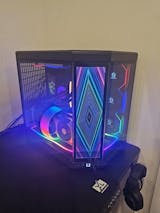An essential factor that may greatly affect your gaming experience is the PC screen resolution at which you play your games. The resolution you choose has an effect on both the visual quality and the frame rate at which you play. In this tutorial, we'll go over the options for gaming resolutions so you can pick the one that works best with your rig.
Resolution Understanding
The term "resolution" is used to describe the total number of pixels in a display or video game. It is often written as a sum of the width and height of the pixels (for instance, 1920 x 1080, abbreviated 1080p). More pixels in a higher resolution equals crisper, more detailed visuals.
Typical Gaming Resolutions
The most common game resolution is 1080p (1920 x 1080), commonly called Full High Definition (FHD). It's a favorite of both casual and professional players because it finds a happy medium between visual quality and performance. Most current graphics cards are more than capable of 1080p gaming.
Second, 1440p (2560x1440) provides a significant boost in picture quality over 1080p and is sometimes referred to as Quad HD or QHD. You can see greater detail in games without significantly decreasing performance. However, a strong graphics card may be needed to maintain consistently high frame rates at this resolution.
Thirdly, 4K (3840x2160): 4K gaming, often known as Ultra HD, offers unmatched visual quality with jaw-dropping levels of detail and clarity. However, a powerful gaming PC or console is required to achieve fluid frame rates at this resolution. The price of entry for 4K gaming gear is high, but the visual quality is stunning.
Ultra-wide resolutions, such as 2560x1080 or 3440x1440, are preferred by some players for a more immersive gaming experience. These higher pixel counts are the best resolutions for a more immersive experience in games like racing and first-person shooters (FPS).
Selecting the Best Resolution for You
Video Game System: Your video card should support the resolution you choose. You can't go wrong with 1080p on a midrange or budget gaming PC. If your machine can handle it, try 1440p or even 4K resolution.
A good monitor is essential, so give some thought to its features and specifications. Verify that the resolution you want to use is supported by your display. Higher refresh rates and adaptive sync technologies (like G-Sync or FreeSync) are common in gaming displays and may vastly improve the quality of your gaming experience.
"Performance versus Visuals" Think about what you value most. Do you play games competitively and place a premium on having a fluid experience? If so, you might find that 1080p or 1440p is more to your liking. On the other hand, 4K might be the best option if you value spectacular images above raw performance.
Budget: Think about how much you can spend on a gaming PC and a monitor. Keep in mind that the higher the PC gaming resolution, the more expensive the technology will need to be.
Genre of the Game: Your preferred gaming genre may also have an impact on your final decision. High frame rates and low resolutions are ideal for fast-paced competitive games, while higher frame rates and higher resolutions are ideal for games with compelling stories or breathtaking visuals.
In the end, your own preferences, gaming rig, and play style will determine the ideal resolution for gaming. Finding the sweet spot between visual quality and performance that works for you is essential. Remember that gaming is meant to be fun, so pick a resolution that works for you, whether that's the industry-standard 1080p, the eye-popping 4K, or something in between. If you want your gaming experiences to really pop, adjust the screen's resolution accordingly.















